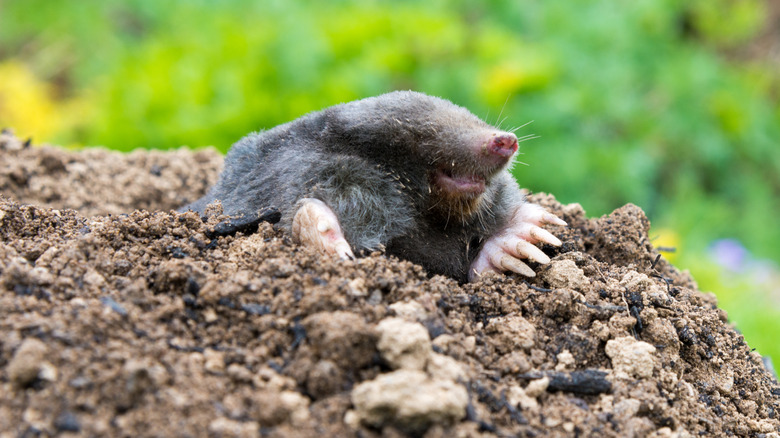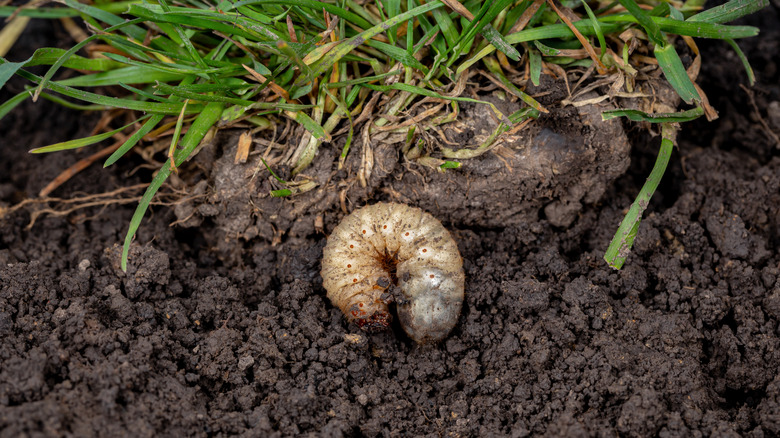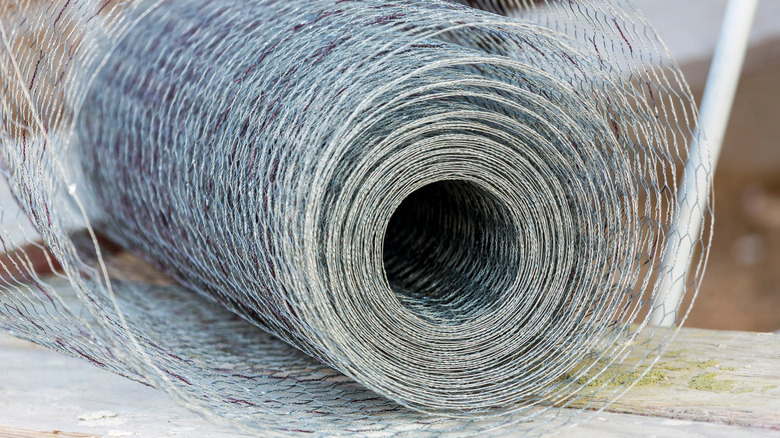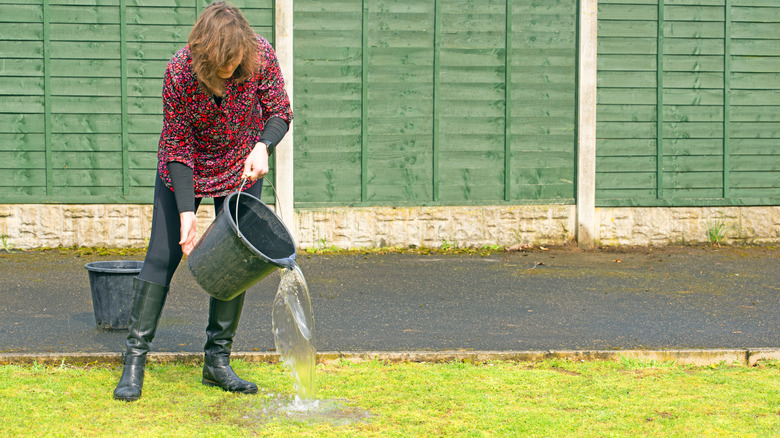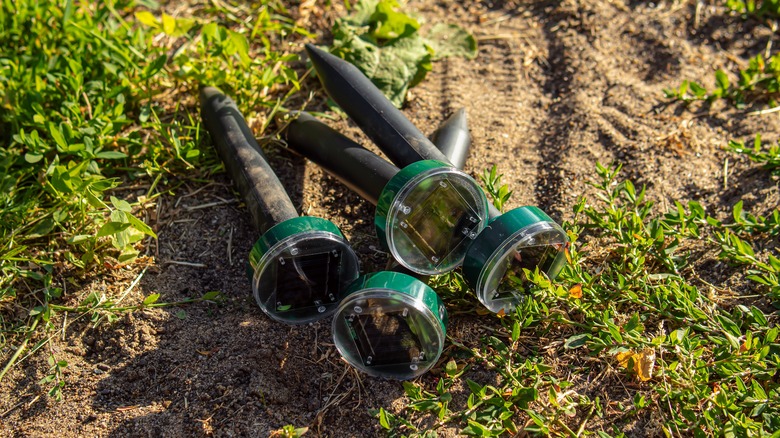9 Ways To Naturally Deter Moles From Your Yard Or Garden (And 7 To Skip)
We may receive a commission on purchases made from links.
If you've been spending long hours getting your lawn looking smart, it can be unspeakably frustrating to have mole tunnels continually popping up. These small mammals are known for their exceptional burrowing skills, and as they dig through the ground with their claws in search of food, they can create a maze of tunnels in a very short span of time. According to EBSCO, moles have the capability of digging up to 25 feet of dirt in just one hour!
Moles are important members of the ecosystem. They can even help control unwanted insects around your property and possibly contribute to healthy soil aeration. Still, their digging abilities can create a conundrum for homeowners. Tunnels can quickly mar your yard and garden, and as fast as you stamp them down, they tend to appear again. Before resorting to traps for moles, there are a variety of other methods to consider. You'll likely need to use a combination of techniques to help deter moles from your property, and you'll also want to skip methods that are unlikely to work.
Control grubs in your yard to avoid attracting moles
It's worth understanding why moles could be attracted to your yard in the first place. Moles enjoy eating a variety of insects — especially grubs. So, if you're seeing a lot of mole tunnels all of a sudden, chances are they have found a reliable source of food around your yard. Grubs are the larvae of beetles, which stay underneath the ground until they emerge in their adult form.
Controlling grubs in your yard can make your property less of a target for moles. As a bonus, grub control is also beneficial to your lawn, as these larvae can do some serious turf damage. Commercial pesticides can effectively control grubs, but should be regarded as last resorts for severe infestations, as they can harm things like earthworms. Two natural methods of control for grub worms include milky spore bacteria (mainly effective against Japanese beetle grubs) and beneficial nematodes (mainly effective against white grub species). If you want to try out one of these biological control methods, you'll need to source a product from a reputable supplier. Nematodes are generally shipped and applied live. You will need to water them into the soil, and apply when the sun is low or there is cloud cover.
Avoid overwatering your lawn to reduce both grubs and moles
Another way you can help control both grubs and moles, sans pesticides, is by tweaking your watering routine. Since grubs flourish in wet environments, an overwatered lawn could increase their numbers and lure hungry moles to the area. Also, when it's time for female beetles to lay their eggs, they primarily seek out soil that has a high level of moisture.
Instead of watering your lawn a few times a week, consider infrequent irrigations that use more water at one time. This will strengthen grass roots, all while allowing the ground to dry in between watering sessions. Most lawns need about an inch of water every week during their active seasons, and most automatic sprinklers with rotating heads will provide this in 30 to 40 minutes. And of course if it rains, you can decrease the time you run your sprinkler. Consider using a rain gauge to help you determine whether your lawn needs additional watering. Another option is to use a 2-in-1 Rain Gauge and Sprinkler Gauge to help you know exactly how much water your lawn is getting from both natural and supplemental sources of irrigation.
Establish a thick, dense layer of turfgrass
When it comes to deterring moles, it's also important to consider the density of your turf. A thinner lawn is generally more attractive to moles because they can burrow and make tunnels easier with fewer grass roots to content with. Taking the right steps to ensure thicker grass may deter these activities, all while making your yard look more attractive.
Growing a thicker and denser lawn doesn't happen overnight. Regular mowing (at the correct height) is key for encouraging dense turf. However mowing too short can reduce root density, so consider keeping your lawn mowed at a height of between 2 ½ and 3 inches to promote denser root growth. Lawn aeration can also improve soil health and lead to denser turf over time. Depending on your soil type and foot traffic, aeration may be needed once or twice a year.
Exclude moles from your garden with sunken fencing or barriers
Controlling common food sources that could draw moles to your garden is a good start. However, such methods cannot physically prevent these small mammals from entering your outdoor spaces entirely. This is where you might consider longer-term exclusionary mole deterrents like sunken fencing and mole barriers. Fencing can be an effective way to protect smaller spaces such as vegetable gardens and flower beds from the burrowing impacts of moles.
To get started, dig a trench around the perimeter of your garden that's at least 12 to 30 inches deep and 12 inches wide. Then, gather your fencing material and prepare to bury it into the trench. Choose a material that moles cannot easily penetrate, such as one made with steel hardware cloth or solid sheet metal. Bend the bottom of the fence into the shape of an "L," with the lower part facing outward away from the garden bed. Make sure at least 6 inches of the fence sticks up above the ground as another way to prevent burrowing and mole hills.
Consider fencing around your entire yard, too
If you want to exclude moles from your whole yard, you may need to consider fencing around the perimeter of this area, too. The fence can act as a physical barrier to prevent moles from crossing over to your property from another. While perhaps not the cheapest solution for deterring moles, properly constructed fencing can offer a long-term, chemical-free solution. Aside from moles, there's also other reasons why you'll want to consider a fence for your yard.
Fencing height is key for keeping out wildlife like deer and coyotes. But since moles travel underground, building an 8-foot-tall fence will not be effective against these animals if the material doesn't extend further down, too. To help keep out moles, you'll need to extend the structure 2 feet below ground. Choose steel hardware cloth or wire mesh materials, and also angle them in an L-shape on the bottom for the best protection possible.
Test a castor oil-based repellent
Castor oil is one ingredient that may be off-putting to moles because the ricinoleic acid content can purportedly upset their digestive systems. If you have an active mole problem, you might consider using a commercial repellent with castor oil as an active ingredient. One example is EPIC Repellents Professional Mole Scram, which comes in a 22-pound bucket of granules that you apply. Aside from moles, these commercial products may also help with short-term control of other grub-seeking wildlife from your yard, such as voles.
Castor oil still has some limitations though, so using a commercial repellent of this kind shouldn't be your only method of mole control. Also, be aware that castor oil can be mildly toxic to both humans and pets in large quantities. Exercise caution if you have young children and fur babies who might hang out in your yard. As always, follow all product instructions and precautionary directions.
Or try a DIY castor oil repellent
Not only can you buy castor-oil-based repellent products, but you can also use castor oil to create a DIY pest control option some gardeners swear by for getting rid of moles. If you're interested in trying castor oil as a mole deterrent but want a more budget-friendly solution, all you'll need is a small amount of castor oil along with dish soap and water. Like commercial castor oil repellents, the idea again is to deter the moles with the ricinoleic acid content.
Make your own solution containing 1 gallon of water with 6 ounces of pure castor oil and 2 tablespoons of liquid detergent. Further dilute at a ratio of 1 ounce per gallon of water, and treat the entire problem area, as moles have been known to bypass spot treatments and burrow elsewhere. You'll also need to reapply the liquid DIY formula for continuous results, especially after irrigation or rainfall. Water the lawn before and after applying the DIY castor oil repellent. As with commercial castor oil-containing products, it's wise to keep young children and pets away from this ingredient in case of accidental ingestion and abdominal upsets.
Drive moles out of your yard with targeted streams of water
You can also try driving moles out of any active tunnels with water from a garden hose. This method is not recommended as a way to harm them. Instead, it might convince the moles that your yard may not be the best place for them to dig around in after all.
To use this strategy, take a garden hose and place it directly into a mole burrow. Turn on the water for up to 15 minutes at a time. Alternatively, you may pour buckets of water into the burrow. If you're lucky, you might even see the mole dig up to the surface and leave. Keep in mind that this method is more likely to be effective when a mole is new to your yard and hasn't excavated an extensive tunnel network yet. Also, even if it does flush the mole out, it won't necessarily prevent them from burrowing elsewhere in other areas of your property.
Attract owls to your yard for natural mole control
There are several different mole predators that can help to control the population naturally. You may not necessarily wish to invite predators like coyotes and snakes into your yard, but you'll want to make an exception with owls. Moles are a key source of food for owls and other birds of prey.
To attract owls as a complementary method for deterring moles, consider placing an owl box on a building, such as a shed or barn, or even a tall tree as a last resort. This will allow the owls to have a safe space to hang out in between hunting. Just make sure the box is at least 12 feet off the ground to provide the owl with a good vantage point of their surroundings. There are many benefits of adding an owl nest box to your garden, with mole control being just one of them.
Don't bother flattening tunnels simply to deter moles
While some moles burrow up to 12 inches below the ground, they can build tunnels close to the surface, too. You may have read advice on flattening them with a shovel, lawn roller, or even your foot. This can reveal if the tunnel is still considered "active," (especially if it comes back within 24 hours of flattening it), before setting mole traps. However merely flattening tunnels doesn't do much against these burrowing critters.
In some cases, the tunnels may come back within hours, which is an indication that the moles are still active and next steps are required (such as human trapping or using water). Flattening a mole tunnel also won't deter the animals from your property more generally. Even if stamping down the soil makes them rethink using that particular tunnel, they might burrow within another spot of your yard, or perhaps dig lower. This method also doesn't address the problem of more permanent tunnels deeper underground. If you do choose to use this method in conjunction with trapping, look for a catch and release trap (such as the Havahart 2-Door Humane Catch and Release Live Animal Trap) that will allow you to relocate any caught moles without harming them.
Don't waste time with pinwheels for moles
Dotting pinwheels around your yard or garden can be a fun way to add some character while possibly repelling certain nuisance birds. You may have heard that pinwheels might also serve as a natural scare tactic against moles. The idea here is that when the wind makes the pinwheels move, subsequent vibrations within the ground then frighten off moles.
Some people have reported success with pinwheels on an anecdotal basis, and they are considered an age-old "hack" for combating moles. However, this method doesn't have any strong scientific backing. Although moles demonstrate sensitivity to vibrations in the earth, they also become habituated to ongoing exposure — to the point where moles routinely take up residence next to busy railroad lines or highways that see heavy truck traffic. At the very best, a pinwheel might yield some early deterrence, but once moles get used to the vibrations, pinwheels will probably only serve as a decoration.
Skip planting caper spurge
When it comes to deterring pests naturally, lots of online articles tout a variety of plants that can allegedly send critters running, without the need for chemicals. Such is the case with caper spurge (Euphorbia lathyris) and moles, which is a toxic plant that's said to kill pests in your garden. Also nicknamed "mole plant," this herbaceous plant has garnered a reputation of acting as a possible mole deterrent, though this is based on anecdotal evidence only.
The overall efficacy of caper spurge as a mole deterrent is questionable, and most university extensions agree that the plant's ability to repel moles is a myth. Planting caper spurge in your yard could also have some unintended consequences because of its poisonous qualities. It's considered toxic to humans as well as dogs, cats, and horses. The plant can have ornamental benefits, but many gardeners also find its weedy nature challenging. Collectively, planting caper spurge in your yard or garden probably isn't a worthwhile mole management strategy.
Don't plant daffodils for the sole purpose of deterring moles
Daffodils (Narcissis) are popular flowers to plant in home gardens. Not only do they bloom into bright colors in the spring, but some people even believe that these flowers can prevent certain pests from visiting your garden. Daffodils are said to help deter moles thanks to the lycorine content in their bulbs. The assumption is that if a mole consumes this toxin, they could theoretically learn to stay away from the plants.
But before you start lining your garden beds with daffodils, know that there isn't any hard evidence that shows these plants as natural mole deterrents. While some moles might learn to avoid daffodils, this doesn't mean they'll keep out of your yard or garden just because you have a clump of daffs growing. At best, they may adapt to the presence of the bulbs and work around them.
Also don't rely on planted garlic for warding off moles
Word on the street also says that planting garlic may deter moles because of its pungent scent. Moles could possibly run into garlic bulbs growing in your garden and then get a whiff of the sulphurous smell. However, there's not enough concrete evidence to claim that planting garlic will actually deter moles in your garden .
Anecdotally, some people have claimed they've used garlic successfully as a mole deterrent, but the results behind this method are highly mixed, and it's unlikely that a few garlic plants will send moles running for the hills. The bottom line is that you should plant this allium only if you truly want to grow your own garlic. If moles subsequently avoid it, then that could be a welcome bonus. Like other plants, moles could possibly dislike garlic, but simply burrow around it instead of leaving your garden entirely.
Don't think onions will send moles scampering either
Onions are another member of the allium family that holds similar folklore when it comes to deterring moles. As with garlic, the claim with onions is that burrowing moles might catch the scent of the plant's pungent roots and then steer clear of the area. Onions contain sulfonic acid that is said to be off-putting for a variety of pests. But there's unfortunately not much scientific evidence supporting onions as effective mole deterrents.
Bottom line: you're unlikely to fully deter moles from entering your yard or garden by growing a few onions. So rather than pinning your hopes on this hack, grow alliums so you can harvest your own onions, and for their pretty pink or white flowers. And if moles do end up causing slightly less havoc in that area of the yard as a result, hooray!
Don't put your faith in ultrasonic devices for moles
Ultrasonic devices purportedly work by creating vibrations deep in the ground where moles are burrowing. The idea behind these gadgets is that moles may then quickly leave your yard out of sheer annoyance. Aside from moles, these devices are sometimes sold for the purpose of controlling other pests, such as rodents, termites, and even ants. Pets and livestock are said to be spared from the disorienting effects caused by the devices, though.
While it might be tempting to throw money at a mole problem, the efficacy of these ultrasonic devices has not been validated by scientific research. They're unlikely to scare off established moles that are currently in your yard or garden, given the fact that (as outlined earlier) moles can become accustomed to ongoing vibrations. On the flipside, there's of course no harm in trying out one of these devices if you're game for an experiment, except that it might end up being a waste of 40 odd bucks. There may be a slim chance that the ultrasonic pulses scare off a new mole that's eyeing up your garden — but don't assume they'll ensure a mole-free yard.
